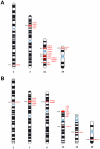Genetic evidence supporting the association of protease and protease inhibitor genes with inflammatory bowel disease: a systematic review
- PMID: 21931648
- PMCID: PMC3169567
- DOI: 10.1371/journal.pone.0024106
Genetic evidence supporting the association of protease and protease inhibitor genes with inflammatory bowel disease: a systematic review
Abstract
As part of the European research consortium IBDase, we addressed the role of proteases and protease inhibitors (P/PIs) in inflammatory bowel disease (IBD), characterized by chronic mucosal inflammation of the gastrointestinal tract, which affects 2.2 million people in Europe and 1.4 million people in North America. We systematically reviewed all published genetic studies on populations of European ancestry (67 studies on Crohn's disease [CD] and 37 studies on ulcerative colitis [UC]) to identify critical genomic regions associated with IBD. We developed a computer algorithm to map the 807 P/PI genes with exact genomic locations listed in the MEROPS database of peptidases onto these critical regions and to rank P/PI genes according to the accumulated evidence for their association with CD and UC. 82 P/PI genes (75 coding for proteases and 7 coding for protease inhibitors) were retained for CD based on the accumulated evidence. The cylindromatosis/turban tumor syndrome gene (CYLD) on chromosome 16 ranked highest, followed by acylaminoacyl-peptidase (APEH), dystroglycan (DAG1), macrophage-stimulating protein (MST1) and ubiquitin-specific peptidase 4 (USP4), all located on chromosome 3. For UC, 18 P/PI genes were retained (14 proteases and 4 protease inhibitors), with a considerably lower amount of accumulated evidence. The ranking of P/PI genes as established in this systematic review is currently used to guide validation studies of candidate P/PI genes, and their functional characterization in interdisciplinary mechanistic studies in vitro and in vivo as part of IBDase. The approach used here overcomes some of the problems encountered when subjectively selecting genes for further evaluation and could be applied to any complex disease and gene family.
Conflict of interest statement
Figures




Similar articles
-
Interventions for the management of abdominal pain in Crohn's disease and inflammatory bowel disease.Cochrane Database Syst Rev. 2021 Nov 29;11(11):CD013531. doi: 10.1002/14651858.CD013531.pub2. Cochrane Database Syst Rev. 2021. PMID: 34844288 Free PMC article.
-
Patient education interventions for the management of inflammatory bowel disease.Cochrane Database Syst Rev. 2023 May 4;5(5):CD013854. doi: 10.1002/14651858.CD013854.pub2. Cochrane Database Syst Rev. 2023. PMID: 37172140 Free PMC article.
-
Vitamin D for the treatment of inflammatory bowel disease.Cochrane Database Syst Rev. 2023 Oct 2;10(10):CD011806. doi: 10.1002/14651858.CD011806.pub2. Cochrane Database Syst Rev. 2023. PMID: 37781953 Free PMC article.
-
Systemic pharmacological treatments for chronic plaque psoriasis: a network meta-analysis.Cochrane Database Syst Rev. 2021 Apr 19;4(4):CD011535. doi: 10.1002/14651858.CD011535.pub4. Cochrane Database Syst Rev. 2021. Update in: Cochrane Database Syst Rev. 2022 May 23;5:CD011535. doi: 10.1002/14651858.CD011535.pub5. PMID: 33871055 Free PMC article. Updated.
-
Systemic pharmacological treatments for chronic plaque psoriasis: a network meta-analysis.Cochrane Database Syst Rev. 2017 Dec 22;12(12):CD011535. doi: 10.1002/14651858.CD011535.pub2. Cochrane Database Syst Rev. 2017. Update in: Cochrane Database Syst Rev. 2020 Jan 9;1:CD011535. doi: 10.1002/14651858.CD011535.pub3. PMID: 29271481 Free PMC article. Updated.
Cited by
-
Alternative medicines as emerging therapies for inflammatory bowel diseases.Int Rev Immunol. 2012 Feb;31(1):66-84. doi: 10.3109/08830185.2011.642909. Int Rev Immunol. 2012. PMID: 22251008 Free PMC article. Review.
-
Research trends of omics in ulcerative colitis: A bibliometric analysis.Front Med (Lausanne). 2023 Mar 27;10:1115240. doi: 10.3389/fmed.2023.1115240. eCollection 2023. Front Med (Lausanne). 2023. PMID: 37051213 Free PMC article. Review.
-
Seasonal variations in the onset of ulcerative colitis in Japan.World J Gastroenterol. 2013 Dec 21;19(47):9063-8. doi: 10.3748/wjg.v19.i47.9063. World J Gastroenterol. 2013. PMID: 24379632 Free PMC article.
-
Lactococcus lactis As a Versatile Vehicle for Tolerogenic Immunotherapy.Front Immunol. 2018 Jan 17;8:1961. doi: 10.3389/fimmu.2017.01961. eCollection 2017. Front Immunol. 2018. PMID: 29387056 Free PMC article. Review.
-
Regulation of nuclear factor-κB in autoimmunity.Trends Immunol. 2013 Jun;34(6):282-9. doi: 10.1016/j.it.2013.01.004. Epub 2013 Feb 20. Trends Immunol. 2013. PMID: 23434408 Free PMC article. Review.
References
-
- Loftus EV, Jr, Sandborn WJ. Epidemiology of inflammatory bowel disease. Gastroenterol Clin North Am. 2002;31:1–20. - PubMed
-
- Loftus EV., Jr Clinical epidemiology of inflammatory bowel disease: Incidence, prevalence, and environmental influences. 2004;126:1504–1517. - PubMed
-
- Xavier RJ, Podolsky DK. Unravelling the pathogenesis of inflammatory bowel disease. 2007;448:427–434. - PubMed
-
- Hugot JP, Chamaillard M, Zouali H, Lesage S, Cezard JP, et al. Association of NOD2 leucine-rich repeat variants with susceptibility to Crohn's disease. 2001;411:599–603. - PubMed
Publication types
MeSH terms
Substances
Grants and funding
LinkOut - more resources
Full Text Sources
Other Literature Sources
Research Materials
Miscellaneous

